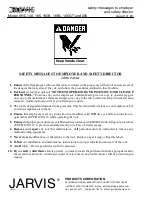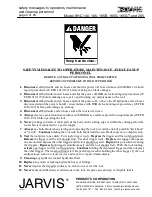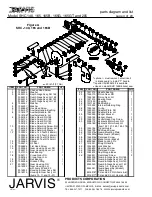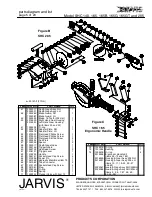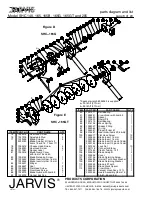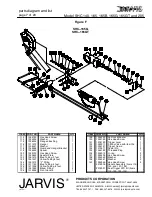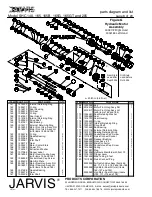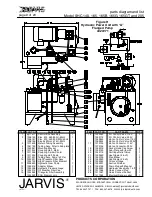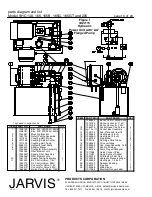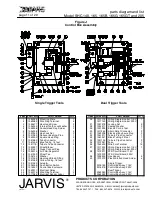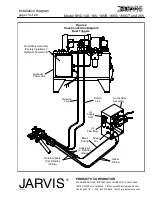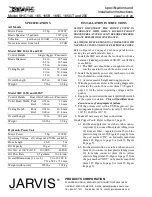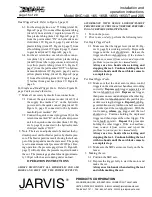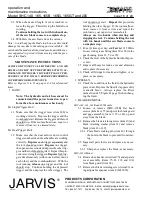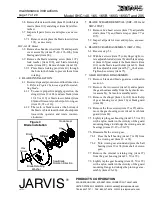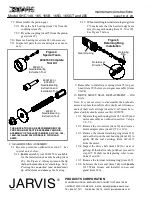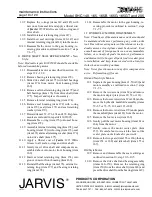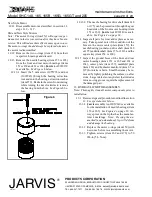
installation and
operation instructions
Model SHC 140, 165, 165B, 165G, 165GT and 205
page 15 of 20
PRODUCTS CORPORATION
33 ANDERSON ROAD, MIDDLETOWN, CONNECTICUT 06457-4926
UNITED STATES OF AMERICA E--MAIL.
TEL. 860-347-7271
FAX. 860-347-6978
WWW.
jarvisproducts.com
JARVIS
6207016::::.
Dual Trigger Tools: Refer to Figure J, page 11.
6.3 For the air supply line: use “Y” fitting (item 124,
Figure F, page 7) to connect black plastic tubing
(item 33) from air filter / regulator (item 15) to
blue plastic tubing (item 122, Figure F, page 7)
from the port marked “IN” on hydraulic man-
ifold (item 187, Figure G, page 8), and to blue
plastic tubing (item 125, Figure F, page 7) from
elbow fitting (item 127, Figure F, page 7) closest
to gear head (item 99, Figure D, page 6).
6.4 For the air return line: use tube to tube connec-
tors (item 34) to connect yellow plastic tubing
(item 19) from tube to pipe connectors (item 34)
to yellow plastic tubing (item 126, Figure F,
page 7) from the port marked “OUT” on hydrau-
lic manifold (item 187, Figure G, page 8), and to
yellow plastic tubing, (item 123, Figure F, page
7) from elbow fitting (item 127, Figure F, page
7) furthest from gear head (item 99, Figure D,
page 6.
For Single and Dual Trigger Tools: Refer to Figure H,
page 9 unless noted otherwise.
7 Make all necessary hydraulic hose connections.
7.1 Connect the quick connect socket (item 29) of
the supply line marked “A” on the hydraulic
power unit to the quick connect plug (item 190,
Figure G, page 8) connected to the hydraulic
manifold port marked “IN.”
7.2 Connect the quick connect plug (item 28) of the
return line marked “B” on the hydraulic power
unit to the quick connect socket (item 180, Fig-
ure G, page 8) connected to the hydraulic man-
ifold port marked “OUT.”
8 Note: There are no adjustments to be made at the hy-
draulic power unit for blade speed or hydraulic pres-
sure. The blade speed is a result of using the full out-
put of the pump and cannot be increased. The pump
is set to a maximum relief pressure of 2000 psi. Dur-
ing operation, the pressure gage (item 13, Figure H,
page 9) will only show the pressure required to make
the cut. The pressure gage should read approximate-
ly 300 psi with the saw running under no load.
OPERATION INSTRUCTIONS
ALWAYS DISCONNECT ALL HYDRAULIC AND AIR
HOSES AND SHUT OFF THE POWER SUPPLY IN
ACCORDANCE WITH OSHA’S LOCKOUT/TAGOUT
PROCEDURES (29 CFR 1910.147) BEFORE PERFORM-
ING ANY REPAIRS OR MAINTENANCE.
1 Turn on the power.
2
Prior to use or daily,
perform the following tests:
For Single Trigger Tools:
2.1 Make sure that the trigger lever (item 188, Fig-
ure G, page 8) is working correctly. Depress the
trigger and the tool should start. Release the
trigger and the tool should stop.
If the tool mal-
functions, remove it from service and report the
problem to your supervisor immediately
.
Always use two hands when starting and
stopping the tool. Continue holding the tool
with two hands until the saw blade comes to
a complete stop.
For Dual Trigger Tools:
2.2 Make sure that the dual anti--tie down control
triggers on the side and rear handles are working
correctly.
Depress
each trigger separately and
the tool should not start.
Depress
one trigger,
then pause one second and depress the other trig-
ger and the tool should not start. Repeat this pro-
cedure reversing the triggers.
Depress
both trig-
gers simultaneously (within one half second of
each other) and the tool should start. With the
tool running,
release
one trigger and the tool
should stop. Continue holding the depressed
trigger and then depress the other trigger. The
tool should not start.
Repeat
this procedure
holding the other trigger.
If the tool malfunc-
tions, remove it from service and report the
problem to your supervisor immediately
.
Always use two hands when starting and
stopping the tool. Continue holding the tool
with two hands until the saw blade comes to
a complete stop.
2.3 Make sure the SHC saw moves freely on the ba-
lancer.
3 Making the cut.
3.1 Position the SHC saw.
3.2 Depress the trigger fully to start the motor and
make the cut.
Always use two hands when starting the tool
and while making the cut.


